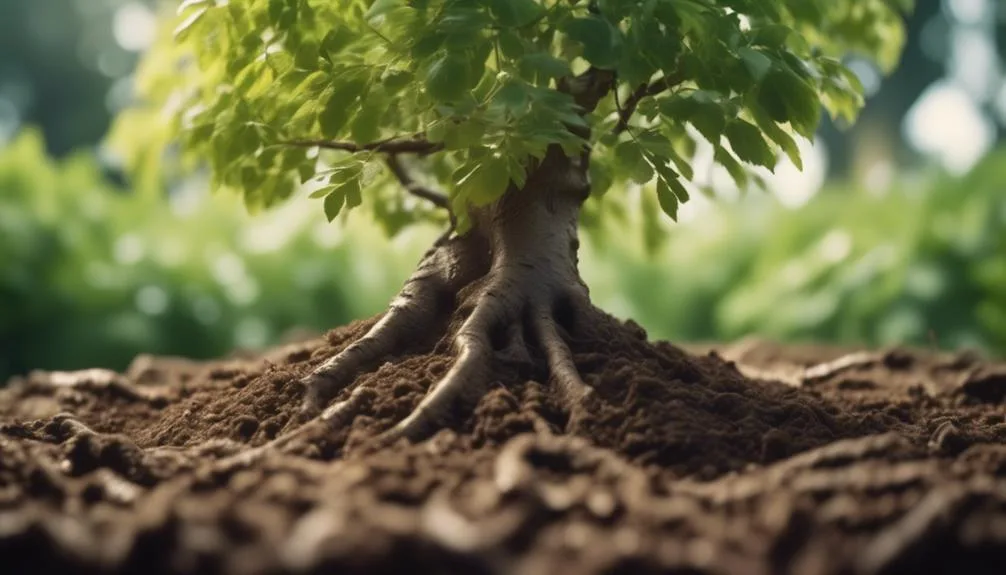Elm trees are known for their grand presence, but can they thrive in alkaline soil?
It's not a simple yes or no. Various factors affect their survival in such conditions. Understanding these factors is crucial for making informed decisions about planting and caring for elm trees in alkaline soil.
Let's explore the relationship between elm trees and alkaline soil to uncover the truth about their compatibility.
Alkaline Soil and Elm Trees
If you're considering planting elm trees in alkaline soil, it's essential to understand how the soil's pH level can impact the health and growth of these trees.
Soil pH directly affects nutrient availability for elm trees. In alkaline soil, with a pH above 7, certain nutrients like iron, manganese, and phosphorus become less available to the trees. This can lead to nutrient deficiencies, stunted growth, and yellowing of leaves.
To address this, you can consider soil amendments to lower the pH and make these essential nutrients more accessible to the elm trees. Additionally, selecting elm tree varieties that are more tolerant of alkaline soil conditions can also help ensure their successful growth.
Understanding the relationship between soil pH and nutrient availability is crucial for creating an optimal environment for elm trees in alkaline soil.
Elm Tree Adaptation to Alkaline Soil
Elm trees adapt to alkaline soil by developing mechanisms to cope with reduced nutrient availability, ensuring their survival and growth in challenging pH conditions. Their tolerance to alkaline soil lies in their ability to adjust their root systems to maximize nutrient uptake.
Elm trees have evolved to form partnerships with specific mycorrhizal fungi, which aid in nutrient absorption from the soil. This symbiotic relationship allows them to access essential nutrients, such as phosphorus, more efficiently in alkaline conditions.
Additionally, elm trees have the capacity to secrete organic acids from their roots, which helps in releasing bound nutrients from the soil, making them more available for uptake.
These remarkable adaptations enable elm trees to thrive in alkaline soil, showcasing their resilience and ability to acclimate to adverse soil pH conditions.
Factors Affecting Elm Tree Survival in Alkaline Soil
When growing elm trees in alkaline soil, it's essential to consider several key factors that can significantly impact their survival and overall health.
- Soil pH
- Elm trees prefer slightly acidic to neutral soil pH levels. Alkaline soil can affect nutrient availability, making it harder for the trees to absorb essential elements like iron and manganese, leading to nutrient deficiencies and stunted growth.
- Nutrient availability
- Alkaline soil tends to bind essential nutrients, making them less available to elm trees. This can lead to nutrient deficiencies, affecting the overall health and vigor of the trees.
Understanding the effects of soil pH and nutrient availability on elm tree survival in alkaline soil is crucial for implementing the necessary measures to improve soil conditions and ensure the successful growth of these trees in such environments.
Tips for Growing Elm Trees in Alkaline Soil
To successfully grow elm trees in alkaline soil, it's essential to implement specific techniques that can help mitigate the challenges posed by the soil's high pH levels. By employing the right growing techniques and soil amendments, you can create a more hospitable environment for elm trees to thrive. Here are some tips to help you nurture elm trees in alkaline soil:
| Growing Techniques | Soil Amendments |
|---|---|
| Planting in raised beds | Adding organic matter |
| Selecting tolerant species | Using sulfur-based products |
| Regular deep watering | Mulching with acidic materials |
Conclusion: Elm Trees and Alkaline Soil
Implementing the recommended techniques and amendments will create an optimal environment for elm trees to flourish in alkaline soil. By adjusting the soil pH and selecting suitable tree species, you can ensure the successful growth of elm trees in alkaline conditions. Here are some key takeaways:
- Soil pH Management
- Test the soil pH regularly to monitor acidity levels.
- Use soil amendments like elemental sulfur or acidifying fertilizers to lower the pH and create a more favorable growing environment for elm trees.
- Tree Species Selection
- Consider planting disease-resistant elm tree varieties that are better adapted to alkaline soil.
- Consult with local arborists or horticulturists to identify elm tree species that have shown resilience in similar soil conditions.
Conclusion
Incorporating the right variety and attentive care, elm trees can thrive in alkaline soil. By monitoring soil pH levels, you can enjoy the beauty and benefits of these resilient trees in your garden.
Happy planting!

My interest in trees started when I first saw the giant sequoias in Yosemite.
I was a teenager then, and I remember thinking, “I need to learn more about this.”
That moment stuck with me.
A few years later, I went on to study forestry at Michigan Tech.
Since graduating, I’ve worked in a mix of hands-on tree care and community education.
I’ve spent over ten years helping people understand how to plant, maintain, and protect the trees in their neighborhoods.
I don’t see trees as just part of the landscape.
They are living things that make a real difference in our daily lives.
